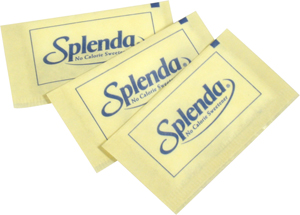|

Here are the facts: Sucralose was discovered by accident in 1975 by an Indian graduate student in the chemistry department of Queen Elizabeth College in London. He and his advisor, Leslie Hough, were trying to create a new insecticide. At one point, Hough asked the student to *test* the powder, but the student thought Hough was telling him to taste it. He told Hough that it was sweet. You cannot make this stuff up, but in case you think I am you can look up the article "The Search for Sweet" written by Burkhard Bilger for the magazine New Yorker, May 22, 2006, and read his interview with these two.
Now, not to bore you or confuse you with chemistry, but molecules that contain bonds between chlorine and carbons are called chlorocarbons or organochlorines.
When you add chlorine to carbon-containing compounds to form organochlorines, they have the potential to be converted into toxic pesticides. Yes, I said potential. Organochlorines as a group are mainly used as pesticides, such as DDT.
Another fact is that organochlorines are fat-soluble by definition, although the truth is that their solubility can vary considerably. Fat-soluble substances tend to accumulate in organ tissues that are high in fat, such as your brain. Then they are permanently stored there.
In an effort to distance Splenda from the organochlorines group, the owners of Splenda (McNeil Nutritionals) made up their own chemical group category name for Sucralose (Splenda), known as chloro-carbohydrate.

Ask any friend or professor that knows about chemistry and they will tell you that this group simply does not exist.
The fact is that Sucralose is an organochlorine, simply because it is a carbon and hydrogen molecule with attached chlorine atoms. Because organochlorines are fat-soluble, Sucralose should be fat-soluble. However, McNeil says that Sucralose is somehow mysteriously an exception to the rule and is *almost* insoluble in fat. This was taken directly from Christine Miller's letter "Web Site Statements Regarding Sucralose," September 28, 2004, 5.
Nevertheless, regardless of the degree of water or fat solubility and the associated possibility of chronic toxicity, organochlorines do not have to be fat soluble to cause harm as they can (yes, can) cause damage to the body immediately upon contact in the form of agitation, lethargy, irregular heartbeat, cough, nausea...you get the idea.
I do not know about you, but when I read this I would have to say that this is not the sort of substance that I want to take a risk with by putting it in my body.
In regards to all of those "safe" studies that the T-Nation author and McNeil reference, the fact is that there are only six published human studies on Sucralose. The longest Sucralose was observed in published human trials was thirteen weeks! Now, McNeil did do unpublished research that studied humans taking Sucralose for six months, but it only focused on the effect of Sucralose on blood sugar in diabetics and did not focus on overall safety. Why did the T-Nation author not mention this?
The bottom line here is that I am not saying for certain that Splenda is bad. However, given all of the public deception, the lack of human studies, and the fact that it is derived from an insecticide, it is not something that I choose to ingest and would warn that the "ingester beware".
 By the way, who does the T-Nation author work for? How many of the T-nation products contain Sucralose as their sweetener?
By the way, who does the T-Nation author work for? How many of the T-nation products contain Sucralose as their sweetener?
Nah...He could not possibly have an angle and a reason to mislead you, now would he? My hope is that he is just misinformed.
Now what is my angle? Exactly. YOUR HEALTH AND MINE.
If you are looking for my recommendation as the best alternative to artificial sweeteners, I would have to say stevia.
If one has weight or blood sugar issues, stevia is an acceptable alternative to natural sweeteners. It basically has no calories, has minimal effect on blood sugar levels, and has been researched extensively to be much safer than artificial sweeteners for human consumption.
So, if one needs to use a sweetener other than the natural caloric sweeteners, stevia is probably the safest, least processed, and has the highest density of sweetness.
Well...you called down the thunder...
You got it.
About Eric Talmant
Eric Talmant is a top lightweight powerlifter and has a "passion for all things nutrition." A 1996 graduate of the University of Evansville, Eric is a certified Metabolic TypingŪ advisor www.mt-advisors.info/EditIndex.php. Talmant is certified to offer the Advanced Metabolic TypingŪ Test as well as order blood work (the Signet MRT Test, U.S. BioTek ELISA IgG allergy test, the High Sensitivity C-Reactive Protein heart health test); as well as the BioHealth Diagnostics Adrenal and Hormone saliva test Profiles.
Eric has competed in the ADFPA, NASA, AAPF, APF, APA, the WPO, and the Raw Unity Meet. He holds the APF Florida state men's open equipped squat record of 678 pounds. He has been ranked in the top in the 75K class among all raw lifters in the United States for the past two years and he was a top equipped lifter in the two years before that.
His best equipped lifts are a 683 pound squat, 391 pound bench press, and a 650 pound deadlift in the 75K weight class. His best raw lifts to date are 485 pound squat without knee wraps, 290 pound bench press, and 635 pound deadlift.
He is also the founder and contest director of the Raw Unity Meet www.rawunitymeet.com which experienced great success in 2008 and 2009.
Talmant brings a unique skill set and 16 years of nutritional experience to his sponsors BMF Sports, Ultra Life, Inc., Critical Bench, and Titan Support Systems. He lives in rural Spring Hill, Florida, and can be reached through his web site at www.erictalmant.com
Return To Eric Talmant's Author Page
Follow Eric's Training Log
More Nutrition Articles
|